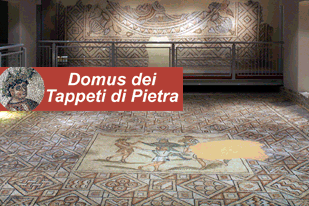XX century art in the mosaics in Casa del Mutilato




XX century art in the mosaics in Casa del Mutilato. Hotel near Casa del Mutilato in the centre of Ravenna.
Photo: 1)La Casa del Mutilato, 2)detail of the building, 3)La Sala dei Mosaici, 4)detail of the Mosaics
In a short note on the 13 March 1939 the architect and designer Matteo Focaccia resumed the building canon of the new Casa del Mutilato in Ravenna.
"The new building wants to express power, order and discipline through the use of simple austere lines with large masonry mass of Ravenna bricks and gentle sober marble demarcation boards.
And while renovating the old building tradition, it conforms to the spirit animating the Mussolinian art".
In the years 1940-41, artists had the historical duty of fixing in the new unfinished building to the memory survival.
Under the giant shadow of Mario Sironi (but also thanks to Campigli, Carrà e Funi) Pompei and Ravenna mosaics were discovered and Gino Severini, big patron of this art, who remarks:" when I first saw the Ravenna mosaics I immediately noticed the analogy between the art of these craftsmen and that of modern Impressionists.
In some ways, in fact, some Matisse's deformations recall figures in Caroling and Meroving Missals; similarly, some Cezanne and Van Gogh's figures recall Maximian portraits and other mosaics, and later on Cubism and Futurism will recall purposes and meanings of Bizantine art.
So the extraordinary decorations in the Casa del Mutilato, in Ravenna capital of mosaics, were born.
The mosaic cycle, perfectly lined up with the building style, it is a homage to the Fascism peculiar Italic warrior cult deriving directly from the spirit of ancient Rome and now alive after the great XIX century wars.
Chronological concomitance with the Second World War could be perceived as actual and a good omen with reference to Italian fighting values.
The portrait of Roman Leader Julius Caesar on horseback (on carton by Anton Giuseppe Santagata) recalls the portrait of Mussolini and the military skill analogies are as evident as the spiritual link between the Fascist present and the Roman past.
The three war panels (on carton by Giovanni Majoli) are nearer to the monumental modernist style of Sironi and Severini, and to the work of wall artists that took part in the Fascist regime decoration programme through realist and national figures always recalling the geometry of Cubism and Futurism .
The use of pebbles from the river Piave in the panel of the First World War is very suggestive also because of the cold tonality offered to the composition.
The panel of the African War has a vortex dynamic composition evoking the Futurist use of multiple space and it is deliberately in contrast with the static composition of the panel of the Spainish War which is totally concentrated on the aid Italians gave to Spanish population as their "Latin brothers".
They are on the whole very interesting works and worthy of mention in the Italian mosaic history during the very intense art production of the Fascist Period.
Prof. Gianni Morelli
The pleasure of fine accommodation in the centre of Ravenna: we recommend the Fabbri hotels for a pleasant stay as follows:
The Centrale Byron Hotel, 3-star hotel in the centre of Ravenna, close to the main momuments;
The Bisanzio Hotel, 4-star hotel in the centre of Ravenna, close to the main momuments;
Once you have reached the hotel and parked your car, forget it and walk everywhere, because everything is within walking distance.
The railway station is near our hotels and within walking distance.





